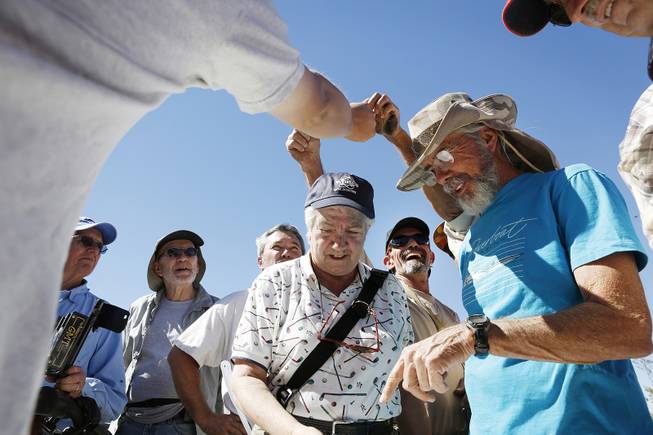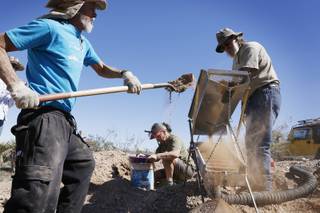
Members collect prizes after the metal detector treasure hunt at a Gold Searchers of Southern Nevada outing at a claim near Meadview, Ariz., on Saturday, Sept. 28, 2013.
Monday, Oct. 14, 2013 | 2 a.m.
More than 20 people set up camp on a plot of Arizona desert in the middle of nowhere, just beyond the Nevada border on a recent weekend. Nothing but brush and dirt are visible as far as the eye can see.
Equipped with shovels, buckets and holstered guns, they spread out along the desert expanse, shoveling dirt and rock into sifters and hunching over tubs of water to dip ridged pans filled with a black-sand-like concentrate into the water. A few waved beeping metal detectors, bending over to dig out buried items when the noise sped up; most only found trash.
Maria Boyle is at the sifting station, dipping a ridged, dinner plate-sized saucer into water, when she spots the unmistakable metal — the one that brought everyone to the desert — in her pan. Her eyes widen and she lets out a shout of joy. She struck gold.
“Bingo,” Boyle shouted.
It’s been 150 years since the Gold Rush sent people scrambling to the deserts of the West, but gold fever still exists today. The group of people combing the desert this day belong to the Gold Searchers of Southern Nevada, a Las Vegas-based club whose members still are hooked on finding the elusive metal.
“They call it gold fever, but it’s the entire experience,” club member George Niederriter said, “from the time you pull up (to the claim) to the time you drive home.”
The group has five claims in the seemingly limitless desert expanse in Nevada and Arizona. They prefer to keep the exact locations secret to those who aren’t members to prevent against claim jumpers.
There are about 400 total members in the club — which gives members unlimited access to each of its claims. The prospectors range from retired men and women looking for a hobby to outdoor enthusiasts to families.
They conduct meetings and outings once a month. During the outings they often have potluck meals, a metal-detecting scavenger hunt and panning contests. Everyone helps one another to find gold. Dues are $45 for the inaugural year’s membership and $30 annually thereafter. The dues cover the member’s entire family.
“Most people need an excuse to do something,” Niederriter said. “Gold is the excuse. Hobbies do not pay typically. What we do pays for itself in being outdoors, the socializing, family bonding … and the cost is minimal.”
Niederriter acts as a guide for inexperienced members. He’s been in the club for more than 15 years and knows almost everything about gold, from its weight compared with water (it’s 19 times heavier) to where to look for it (areas with river-washed rock and quartz).
He sets up his sluice — a metal chute with flowing water hooked up to two tubs of water to simulate a river — and shows people how to pan for gold. He also has coffee brewing and a canopy outside his travel-worn 1980s RV for anyone who wants to rest.
Despite improvements in technology, the process hasn’t changed much since the 1800s, Niederriter said. Prospectors still use pans, sifters, sluices and dry washers that have been made only slightly more efficient than those used in the 1800s.
Finding gold almost always comes down to a little luck and a lot of hard work. Although few people strike it rich, almost everyone leaves these outings with at least a little gold.
“The process is basically the same,” Niederriter said. “If you want to find the material, you’re going to have to work. You have to dig the material, same as back then.”
Few become rich digging for gold. Most only find specks of gold the size of bread crumbs, but the rush of discovery and the prospect of finding more keep them coming back. Few members ever sell the gold they find.
“I became hooked the first time I saw gold,” club president Ian Thaler said. “Who else do you know that has gold and actually dug it up?”
Club member Tony Rhodes rested on his RV steps after discovering his own specks of gold during the club’s September outing. A thin layer of dust covered his sweats, boots and arms from the morning’s work.
He’s spent time the past two years digging for gold. He joined the club after he saw a show on modern gold prospecting and decided to give it a try after he retired. He’s hoarded every piece of gold he’s found ever since.
“I don’t do it for the money,” Rhodes said. “I do it to show people what I found.”
After a moment he holds out a tray filled with vials of gold specks and nuggets the size of a pinhead. The gold glistens in the sun, giving off a faint glow even in the light of day. This is the fruit of his labors. To him, the money paid for gold doesn’t make up for the hard work and memories involved in finding the precious metal.
There’s a thrill to discovering gold. Its elusiveness and value can still draw people to the desert, even 150 years after the Gold Rush.
“There’s plenty of gold out there,” Rhodes said. “You just got to work for it.”


Join the Discussion:
Check this out for a full explanation of our conversion to the LiveFyre commenting system and instructions on how to sign up for an account.
Full comments policy